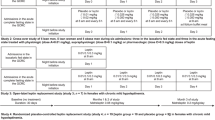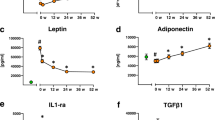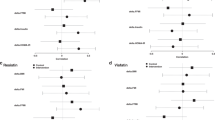Abstract
OBJECTIVE: To investigate whether weekly subcutaneous administration of 60 mg of long-acting pegylated human leptin (PEG-OB) for 8 weeks was able to influence weight loss, metabolic profile and inflammatory status of obese subjects on a mildly hypoenergetic diet (deficit: 3.2 MJ/day).
DESIGN: A prospective, randomized, double-blind and placebo-controlled single-center trial.
SUBJECTS: Twenty-eight healthy, obese subjects (16 women, 12 men; age 22–65 y; body mass index 27.7–38.7 kg/m2).
MEASUREMENTS: Bodyweight, metabolic profile (including lipids), C-reactive protein (CRP) and soluble TNF α-receptor (sTNF-R) 55 and 75 levels.
RESULTS: At the end of the study no significant differences in the delta or percentage weight loss between the placebo (n=14) and PEG-OB (n=14) groups was observed. Also the changes in metabolic profile, CRP, sTNF-R55 and R75 concentrations between the two groups after 8 weeks of treatment did not differ.
CONCLUSION: Weekly injection of 60 mg PEG-OB did not lead to additional weight loss after 8 weeks of treatment. Furthermore, PEG-OB administration did not affect the changes in metabolic profile and the inflammatory status of obese subjects.
This is a preview of subscription content, access via your institution
Access options
Subscribe to this journal
Receive 12 print issues and online access
$259.00 per year
only $21.58 per issue
Buy this article
- Purchase on Springer Link
- Instant access to full article PDF
Prices may be subject to local taxes which are calculated during checkout

Similar content being viewed by others
References
Zhang Y, Proenca R, Maffei M, Barone M, Leopold L, Friedman JM . Positional cloning of the mouse obese gene and its human homologue Nature 1994 372: 425–432.
Pelleymounter MA, Cullen MJ, Baker MB, Hecht R, Winters D, Boone T, Collins F . Effects of the obese gene product on body weight regulation in ob/ob mice Science 1995 269: 540–543.
Halaas JL, Gajiwala KS, Maffei M, Cohen SL, Chait BT, Rabinowitz D, Lallone RL, Burley SK, Friedman JM . Weight-reducing effects of the plasma protein encoded by the obese gene Science 1995 269: 543–546.
Campfield LA, Smith FJ, Burn P . OB protein: a hormonal controller of central neural network mediating behavioral, metabolic and neuro endocrine responses Endocrinol Metab 1997 4: 81–102.
Heymsfield SB, Greenberg AS, Fujioka K, Dixon RM, Kushner R, Hunt T, Lubina JA, Patane J, Self B, Hunt P, McCamish M . Recombinant leptin for weight loss in obese and lean adults—a randomized, controlled, dose–escalation trial JAMA 1999 282: 1568–1575.
Hukshorn CJ, Saris WHM, Westerterp Plantenga MS, Farid AR, Smith FJ, Campfield LA . Weekly subcutaneous pegylated recombinant native human leptin (PEG-OB) administration in obese men J Clin Endocrinol Metab 2000 85: 4003–4009.
Lollmann B, Gruninger S, Stricker Krongrad A, Chiesi M . Detection and quantification of the leptin receptor splice variants Ob-Ra, b, and, e in different mouse tissues Biochem Biophys Res Commun 1997 238: 648–652.
Gainsford T, Willson TA, Metcalf D, Handman E, McFarlane C, Ng A, Nicola NA, Alexander WS, Hilton DJ . Leptin can induce proliferation, differentiation, and functional activation of hemopoietic cells Proc Natl Acad Sci USA 1996 93: 14564–14568.
Cioffi JA, Shafer AW, Zupancic TJ, Smith Gbur J, Mikhail A, Platika D, Snodgrass HR . Novel B219/OB receptor isoforms: possible role of leptin in hematopoiesis and reproduction Nature Med 1996 2: 585–589.
Baumann H, Morella KK, White DW, Dembski M, Bailon PS, Kim H, Lai CF, Tartaglia LA . The full-length leptin receptor has signaling capabilities of interleukin 6-type cytokine receptors Proc Natl Acad Sci USA 1996 93: 8374–8378.
Faggioni R, Fantuzzi G, Gabay C, Moser A, Dinarello CA, Feingold KR, Grunfeld C . Leptin deficiency enhances sensitivity to endotoxin-induced lethality Am J Physiol 1999 276: R136–142.
Loffreda S, Yang SQ, Lin HZ, Karp CL, Brengman ML, Wang DJ, Klein AS, Bulkley GB, Bao C, Noble PW, Lane MD, Diehl AM . Leptin regulates proinflammatory immune responses FASEB J 1998 12: 57–65.
Lord GM, Matarese G, Howard LK, Baker RJ, Bloom SR, Lechler RI . Leptin modulates the T-cell immune response and reverses starvation-induced immunosuppression Nature 1998 394: 897–901.
Howard JK, Lord GM, Matarese G, Vendetti S, Ghatei MA, Ritter MA, Lechler RI, Bloom SR . Leptin protects mice from starvation-induced lymphoid atrophy and increases thymic cellularity in ob/ob mice J Clin Invest 1999 104: 1051–1059.
Ozata M, Ozdemir IC, Licinio J . Human leptin deficiency caused by a missense mutation: multiple endocrine defects, decreased sympathetic tone, and immune system dysfunction indicate new targets for leptin action, greater central than peripheral resistance to the effects of leptin, and spontaneous correction of leptin-mediated defects J Clin Endocrinol Metab 1999 84: 3686–3695.
Santos Alvarez J, Goberna R, Sanchez Margalet V . Human leptin stimulates proliferation and activation of human circulating monocytes Cell Immunol 1999 194: 6–11.
Maffei M, Halaas J, Ravussin E, Pratley RE, Lee GH, Zhang Y, Fei H, Kim S, Lallone R, Ranganathan S, Kern PA, Friedman JM . Leptin levels in human and rodent: measurement of plasma leptin and ob RNA in obese and weight-reduced subjects Nature Med 1995 1: 1155–1161.
Visser M, Bouter LM, McQuillan GM, Wener MH, Harris TB . Elevated C-reactive protein levels in overweight and obese adults JAMA 1999 282: 2131–2135.
World Health Organisation . Energy and protein requirements. Report of joint FAO/WHO/UNU expert consultation. Technical Report Series no. 12 WHO: Geneva 1985.
Matthews DR, Hosker JP, Rudenski AS, Naylor BA, Treacher DF, Turner RC . Homeostasis model assessment: insulin resistance and beta-cell function from fasting plasma glucose and insulin concentrations in man Diabetologia 1985 28: 412–419.
Leeuwenberg JF, Jeunhomme TM, Buurman WA . Slow release of soluble TNF receptors by monocytes in vitro J Immunol 1994 152: 4036–4043.
Kahler A, Geary N, Eckel LA, Campfield LA, Smith FJ, Langhans W . Chronic administration of OB protein decreases food intake by selectively reducing meal size in male rats Am J Physiol 1998 275: R180–185.
Flier JS . Clinical review 94: What's in a name? In search of leptin's physiologic role J Clin Endocrinol Metab 1998 83: 1407–1413.
Farooqi IS, Jebb SA, Langmack G, Lawrence E, Cheetham CH, Prentice AM, Hughes IA, McCamish MA, O'Rahilly S . Effects of recombinant leptin therapy in a child with congenital leptin deficiency New Engl J Med 1999 341: 879–884.
Clement K, Vaisse C, Lahlou N, Cabrol S, Pelloux V, Cassuto D, Gourmelen M, Dina C, Chambaz J, Lacorte JM, Basdevant A, Bougneres P, Lebouc Y, Froguel P, Guy Grand B . A mutation in the human leptin receptor gene causes obesity and pituitary dysfunction Nature 1998 392: 398–401.
Mantzoros CS, Moschos S, Avramopoulos I, Kaklamani V, Liolios A, Doulgerakis DE, Griveas I, Katsilambros N, Flier JS . Leptin concentrations in relation to body mass index and the tumor necrosis factor-alpha system in humans J Clin Endocrinol Metab 1997 82: 3408–3413.
Acknowledgements
We thank Hoffmann-La Roche Inc. for kindly providing pegylated human recombinant leptin (PEG-OB). We also wish to express our sincere appreciation to Gabby Hul for her help in performing the experimental protocols. Finally, we greatly acknowledge the co-operation, patience, and contributions of all of our subjects.
Author information
Authors and Affiliations
Corresponding author
Rights and permissions
About this article
Cite this article
Hukshorn, C., van Dielen, F., Buurman, W. et al. The effect of pegylated recombinant human leptin (PEG-OB) on weight loss and inflammatory status in obese subjects. Int J Obes 26, 504–509 (2002). https://doi.org/10.1038/sj.ijo.0801952
Received:
Revised:
Accepted:
Published:
Issue Date:
DOI: https://doi.org/10.1038/sj.ijo.0801952
Keywords
This article is cited by
-
Differential mechanisms affecting weight loss and weight loss maintenance
Nature Metabolism (2023)
-
Leptin alters energy intake and fat mass but not energy expenditure in lean subjects
Nature Communications (2020)
-
Growth hormone regulates neuroendocrine responses to weight loss via AgRP neurons
Nature Communications (2019)
-
Trends in Obesity and Risk of Cardiovascular Disease
Current Epidemiology Reports (2018)



